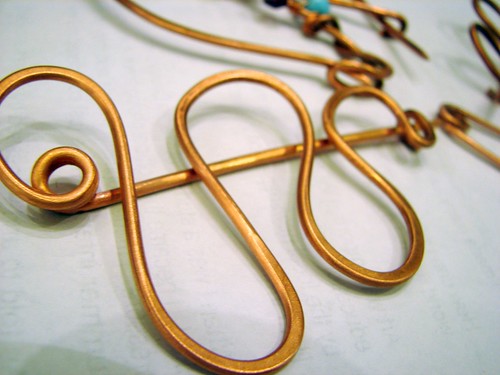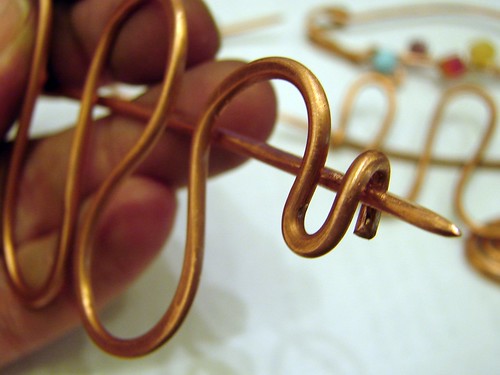On the bench- making fibula style sweater or scarf pins
Decided to forge fibula pins for the scarves and shawls coming into the gallery very soon!
These are very go with the flow type of design just need a body, spring, pin and hinge!

playing with different designs to see what I like...I really like the safety pin with the swirl,
I used 16 gauge for the that the others have 12 or 14 gauge.
These pins are used on loose knit material such as in scarves, shawls and sweaters. I am going to make 2 inch pins next, these are 3 and 4 inches.

the largest one :)

Here you can see the filed tip close up along with the clasp.
I file and polish each pin to take care of every little rough edge ;)
excerpt from http://www.wikipedia.com/
Fibulae were composed of four components: The body, pin, spring, and hinge.
BodyThe body of a fibula is known as either the bow or the plate, depending on the basic form. A bow is generally long and narrow, and often arched. A plate is flat and wide. Plates could be solid or openwork. The body was often decorated. The head is the end of the fibula with the spring or hinge. The foot is the end of the fibula where the pin closes. Depending on the type of fibula, and the culture in question, the head of the fibula could be worn facing up, down or to the side.
PinThe pin that is used to fasten the clothing, is either a continuation of the fibula’s body or a separate piece attached to the body. The fibula is closed by connecting the end of the pin to a catch plate, or pin rest.
SpringThe body and pin meet at either a spring or hinge. The earliest design is the spring which provides tension to the pin. The spring could be unilateral or bilateral. A unilateral spring winds around in one direction only. Unilateral springs are the earliest type, first appearing around the 14th century BC. Bilateral springs that wind around to both sides of the fibula body, appeared around the 6th century BC. Bilateral springs can be very short, with only one or two revolutions per side, or up to 10 cm long. Most bilateral springs are made of one piece of metal and therefore have a spring cord, a piece of wire extending from one end of the spring to the other. The spring cord can pass in front of or behind the fibulae body. Bilateral springs wrap around a pin or axle. These are usually made of iron even if the rest of the of the fibula and spring is copper alloy. In the 1st century AD some fibulae had springs that were concealed under a metal cover that was an extension of the fibula body. These are known as covered springs, or hidden springs.
Hinge
In the late 1st century BC or early 1st century AD a new design appeared in some bow type fibulae. A separate pin was attached to the head-end of the bow with a small hinge. In the second half of the 1st century AD, hinges were introduced to plate type fibulae. One or two small plaques were cast on the back of the plate and a pin was attached to them by a small hinge. Previously, plate type fibulae had bilateral springs attached to the back. In the 3rd century AD, the hinge was placed in the centre of a long transverse bar creating the famous Crossbow fibula design. A few fibulae from a much earlier date also had hinges, although this design feature was very rare and soon died out for nearly five centuries. For example, the Asia Minor Decorated Arc Fibula (Blinkenberg Type XII Variation 16) dating to the 5th century BC.
It is important to note that different types of fibula construction were used contemporaneously. Though the introduction of the hinge was later than the introduction of the spring, the spring remained in use long after the hinge was introduced. Therefore, a given fibula with hinge is not necessarily more recent than one with a spring.
UseFibulae were originally used to fasten clothing. They represent an improvement on the earlier straight pin which was less secure and could fall out. While the head of the earlier straight pin was often decorated, the bow or plate of the fibula provided a much increased scope for decoration. Among some cultures, different fibula designs had specific symbolic meanings. They could refer to a status or profession such as single woman, married woman, man, warrior, or chief. Some Roman-era fibulae may symbolize specific ranks or positions in the Roman legions or auxiliary. In some cultures, fibulae were worn in pairs and could be linked by a length of chain.
These are very go with the flow type of design just need a body, spring, pin and hinge!

playing with different designs to see what I like...I really like the safety pin with the swirl,
I used 16 gauge for the that the others have 12 or 14 gauge.
These pins are used on loose knit material such as in scarves, shawls and sweaters. I am going to make 2 inch pins next, these are 3 and 4 inches.

the largest one :)

Here you can see the filed tip close up along with the clasp.
I file and polish each pin to take care of every little rough edge ;)
excerpt from http://www.wikipedia.com/
Fibulae were composed of four components: The body, pin, spring, and hinge.
BodyThe body of a fibula is known as either the bow or the plate, depending on the basic form. A bow is generally long and narrow, and often arched. A plate is flat and wide. Plates could be solid or openwork. The body was often decorated. The head is the end of the fibula with the spring or hinge. The foot is the end of the fibula where the pin closes. Depending on the type of fibula, and the culture in question, the head of the fibula could be worn facing up, down or to the side.
PinThe pin that is used to fasten the clothing, is either a continuation of the fibula’s body or a separate piece attached to the body. The fibula is closed by connecting the end of the pin to a catch plate, or pin rest.
SpringThe body and pin meet at either a spring or hinge. The earliest design is the spring which provides tension to the pin. The spring could be unilateral or bilateral. A unilateral spring winds around in one direction only. Unilateral springs are the earliest type, first appearing around the 14th century BC. Bilateral springs that wind around to both sides of the fibula body, appeared around the 6th century BC. Bilateral springs can be very short, with only one or two revolutions per side, or up to 10 cm long. Most bilateral springs are made of one piece of metal and therefore have a spring cord, a piece of wire extending from one end of the spring to the other. The spring cord can pass in front of or behind the fibulae body. Bilateral springs wrap around a pin or axle. These are usually made of iron even if the rest of the of the fibula and spring is copper alloy. In the 1st century AD some fibulae had springs that were concealed under a metal cover that was an extension of the fibula body. These are known as covered springs, or hidden springs.
Hinge
In the late 1st century BC or early 1st century AD a new design appeared in some bow type fibulae. A separate pin was attached to the head-end of the bow with a small hinge. In the second half of the 1st century AD, hinges were introduced to plate type fibulae. One or two small plaques were cast on the back of the plate and a pin was attached to them by a small hinge. Previously, plate type fibulae had bilateral springs attached to the back. In the 3rd century AD, the hinge was placed in the centre of a long transverse bar creating the famous Crossbow fibula design. A few fibulae from a much earlier date also had hinges, although this design feature was very rare and soon died out for nearly five centuries. For example, the Asia Minor Decorated Arc Fibula (Blinkenberg Type XII Variation 16) dating to the 5th century BC.
It is important to note that different types of fibula construction were used contemporaneously. Though the introduction of the hinge was later than the introduction of the spring, the spring remained in use long after the hinge was introduced. Therefore, a given fibula with hinge is not necessarily more recent than one with a spring.
UseFibulae were originally used to fasten clothing. They represent an improvement on the earlier straight pin which was less secure and could fall out. While the head of the earlier straight pin was often decorated, the bow or plate of the fibula provided a much increased scope for decoration. Among some cultures, different fibula designs had specific symbolic meanings. They could refer to a status or profession such as single woman, married woman, man, warrior, or chief. Some Roman-era fibulae may symbolize specific ranks or positions in the Roman legions or auxiliary. In some cultures, fibulae were worn in pairs and could be linked by a length of chain.

Comments